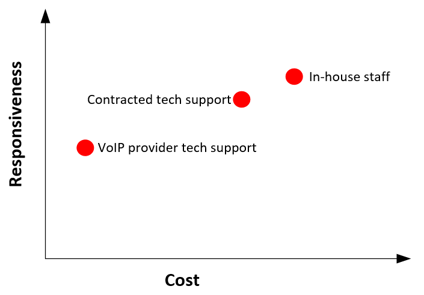
Information and Communications Technology (ICT) often comprises a substantial portion of the budget for many businesses, a large part of which goes to paying the wages of support staff. Larger enterprises may need to employ a full-time, in-house team of professionals to support all their ICT services and assets, including VoIP communications systems.
However, smaller businesses have limited budgets and few ICT-related tasks to justify a full-time or even a part-time ICT position. It’s more difficult for these firms to support their communications systems without wasting valuable and often scarce resources.
In this article, we hope to provide you with insight on how to design the best support structure for your VoIP communications services without overextending your budget.
The importance of communication
Unsurprisingly, the average telecom expenditure is high among businesses. Communication is a critical component to the success of any business, and ensuring that your communications system remains up and running at all times is of utmost importance.
Two essential components that determine the reliability of any VoIP communications system are the technology itself and the network design. Of course, modern VoIP systems have inherent redundancy and robustness built in; however, people are another vital component of ensuring reliability. Specifically, we're referring to the technical personnel who respond to problems, questions, issues and concerns.
ICT support personnel for VoIP
Technical personnel that support your VoIP systems can take various forms, such as:
- In-house staff: These are professionals you’ve hired as full-time or part-time employees of your business. They are located physically within your brick-and-mortar enterprise locations and report to your company’s management.
- Contracted technical support: This is a third-party company or individual that is hired on contract to respond to specific problems within a particular service level agreement (SLA). Such support is not typically paid hourly, but rather on a standard monthly or per-case basis depending upon the SLA. Assistance can be delivered via the telephone, remotely, or on-site, depending upon the agreement.
- VoIP provider technical support: All VoIP providers deliver some level of technical support as part of their offerings. Whether you purchase a cloud-based UCaaS subscription or an on-premises VoIP solution, the provider will offer technical support, the level of which depends upon a variety of factors.
How can you best mix and match these support options to get the most bang for your buck? Before examining that, we’ll have to look at the kind of support required for the various VoIP solutions you can choose.
VoIP solution types
There are three main types of VoIP solutions that today’s providers offer. We have discussed these in past articles, so I’ll just summarize them briefly here.
- On-premises deployments: These use either a physical server with IP telephony software running a SIP server or an IP PBX appliance device. These require physical rack space within the enterprise and network resources to connect to local and remote users.
- VoIP server virtualization: This uses system virtualization technologies to deploy VoIP servers as virtual machines (VMs). This makes deployment much easier than on-premises deployments because you can deploy on a local VM infrastructure or a VM hosting service in the cloud using a service such as Azure or AWS.
- Cloud-based VoIP services: Cloud-based services are delivered using off-premises infrastructure completely managed and maintained by the provider. Your organization doesn’t need to deal with any configuration, setup or maintenance of the servers. VoIP endpoints connect to the service via the internet.
Note that while the choice of solution type impacts the administration and management of the system, the service remains virtually identical from the user’s point of view.
Mixing and matching solutions and support
What are the implications of the various types of support and VoIP services? Well, first look at the following graph, which illustrates how the responsiveness and the cost vary for the three types of support.

Now compare this with the following graph, which shows the administrative overhead of specific solutions compared to their costs:

Note that the on-premises deployment and VoIP server virtualization options have a high initial cost of deployment. Cloud-based VoIP services are subscription-based and typically charge a monthly cost per single VoIP user.
For a small number of users, the cost of a cloud-based solution is comparatively low, but as the number of users increases, the price also increases compared with VoIP server virtualization and on-premises VoIP deployments. This is why the cloud-based VoIP services cover a range of costs in the diagram above.
Implications
For small and medium-sized businesses, combining a cloud-based VoIP service with provider-offered technical support is normally the best option. For a low monthly cost, you cover all your needs. Many cloud-based providers offer different levels of support depending on the package you choose. You can pay a little extra to include additional support, both remote and on-site (if offered).
As the number of users in your business increases to dozens or hundreds, such a solution becomes less cost-effective, and moving to a VoIP server virtualization solution may be preferable. This will increase the administrative overhead, which, in turn, may require additional support beyond what the VoIP provider is willing to provide. Depending on your organization’s size, it may be beneficial to either contract out such support or get an in-house person on your team.
For larger enterprise entities with hundreds or even thousands of users, on-premises deployment is the most cost-effective solution. The initial investment may be comparatively large, but the cost is quickly recovered due to excellent ROI. To support such a service, either contracted or in-house technical support is a must, with the latter being the preferred choice.
Conclusion
Placing the different support structure options within the context of the size of the enterprise, the type of VoIP service used, and the level of tech support required helps businesses and organizations balance their unified communications needs against the cost of supporting them.
You may also like:
How to choose a reputable VoIP service provider
Hosted vs. on-premises IP PBX: Which is the better choice?
Yeastar's P-series cloud edition PBX System









Comments